Discover 11 hidden attractions, cool sights, and unusual things to do in Dunkeld (United Kingdom). Don't miss out on these must-see attractions: Dunkeld Cathedral, Ossian's Hall of Mirrors, and Niel Gow's Oak. Also, be sure to include The Hermitage in your itinerary.
Below, you can find the list of the most amazing places you should visit in Dunkeld (Scotland).
Table of Contents
Dunkeld Cathedral

Church in Scotland. Dunkeld Cathedral is a Church of Scotland place of worship which stands on the north bank of the River Tay in Dunkeld, Perth and Kinross, Scotland. Built in square-stone style of predominantly grey sandstone, the cathedral proper was begun in 1260 and completed in 1501. It stands on the site of the former Culdee Monastery of Dunkeld, stones from which can be seen as an irregular reddish streak in the eastern gable.
It is not formally a 'cathedral', as the Church of Scotland nowadays has neither cathedrals nor bishops, but it is one of a number of similar former cathedrals which has continued to carry the name.[1]
Address: 10 Cathedral St, PH8 0AW Dunkeld
Ossian's Hall of Mirrors

Tourist attraction in Scotland. Ossian's Hall of Mirrors is a Georgian structure located at The Hermitage in Dunkeld, Scotland.[2]
Niel Gow's Oak
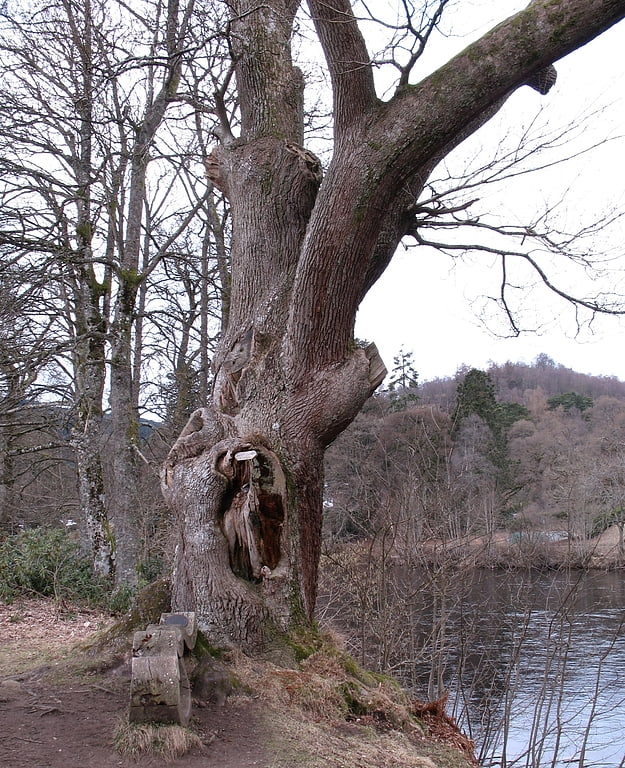
Niel Gow's Oak is a 300-year-old tree near Dunkeld and Birnam, Perth and Kinross, Scotland. It is closely associated with the Scottish fiddler and composer Niel Gow, who lived in nearby Inver. Gow is said to have composed many of his most famous tunes whilst sitting beneath the oak. The connection is commemorated by a plaque and engraved bench. The tree has been entered into the Scottish and European Tree of the Year competitions. The tree was badly damaged by storms in 2011 and 2012.[3]
The Hermitage
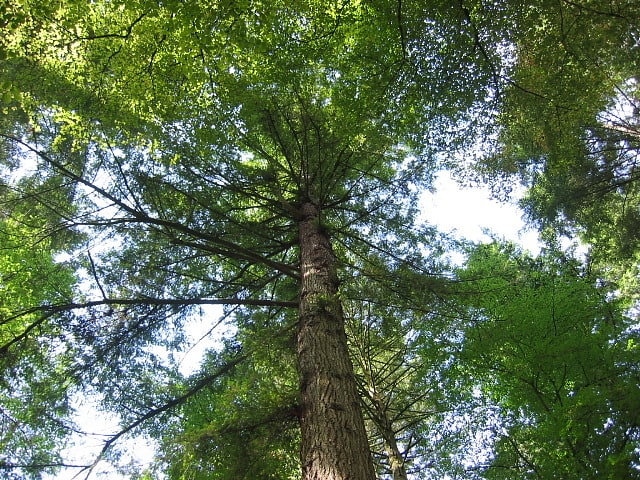
National forest in Scotland. The Hermitage is a National Trust for Scotland-protected site in Dunkeld, Perth and Kinross. Located just to the west of the A9, it sits on the banks of the River Braan in Craigvinean Forest. It was created by John Murray, the third Duke of Atholl, who lived in nearby Dunkeld House, in the 18th century to honour the blind bard Ossian. It is home to Ossian's Hall of Mirrors and Ossian's Cave, Georgian follies. The hermit's cave was built around 1760 for the third Earl of Breadalbane, who unsuccessfully advertised for a permanent eremite. The guide in 1869, Donald Anderson, dressed up with a long beard of lichens and clothes of animal skins.
Also in its grounds are several Douglas-fir trees — one of which was the first tree in Britain to reach 200 feet (61 m) in height. Known as the Hermitage Douglas-fir, it eventually reached a height of 201.1 feet (61.3 m). The tree was blown over due to high winds in the early hours of 13 January 2017. Thought to have been planted in the 1750s, it was, therefore, around 267 years old at the time it fell.
Visitors to the site can undertake various walks. The most popular walk is the 0.75 miles (1 km)-long journey to Ossian's Hall. Wheelchairs are accommodated via a pass-for-all route. There is also a link to a thirty-mile network of footpaths beyond The Hermitage to various parts of Dunkeld. These paths date back to the 18th century.
Originally, the popular riverside path purposely deviated away from the river at about a half-mile from the car park. This was to build up the visitors' anticipation for the waterfall (the Black Linn Falls) that is to be found a short distance ahead. Another path, running parallel to the riverside path, is wider, the purpose for which, it is believed, was to accommodate horse and carriages. Hermitage Bridge, dating from 1770, is located nearby. Standing next to it, and appearing to be growing out of it, is a Cedar of Lebanon, which is believed to be the oldest tree at The Hermitage.[4]
Birnam Arts
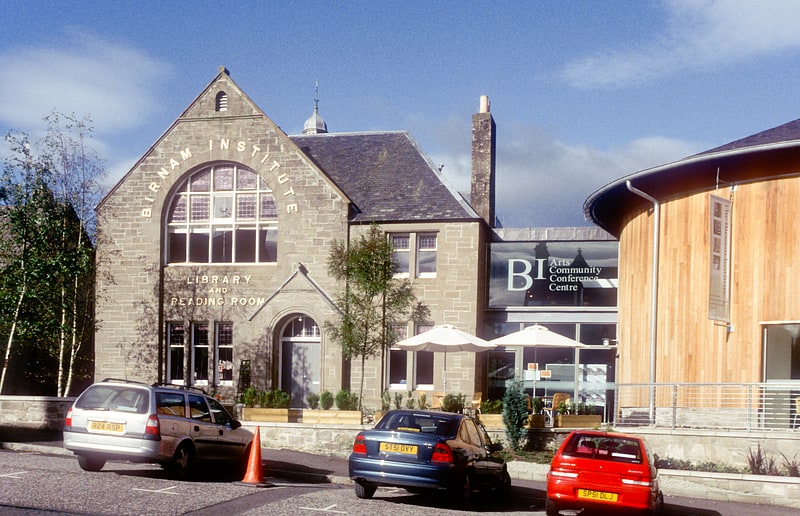
Art institute. Birnam Arts is a multipurpose arts centre in Birnam, Perthshire, central Scotland. It is also known as the Birnam Arts and Conference Centre, and was originally named the Birnam Institute. It is a not for profit organisation owned by the community.[5]
Address: Station Rd, PH8 0DS Dunkeld
Birnam Oak

Tourist attraction in Scotland. The Birnam Oak is an example of Sessile oak at Birnam, Perth and Kinross, Scotland. Sometimes known as Macbeth's oak, as it is a relic of Birnam Wood, mentioned in William Shakespeare's play, the tree is found in a strip of woodland on the south bank of the River Tay. The trunk is 5.5 metres wide and its large spreading branches have latterly been supported on a number of struts to prevent them from collapsing under their own weight. The exact age is unknown, but the girth suggests an age of around 600 years old which would mean it was already a mature tree at the time of Shakespeare's presumed visit to Perthshire in 1589. The tree is listed by Forestry and Land Scotland as one of Scotland's most famous oak trees.[6]
Craigvinean Forest
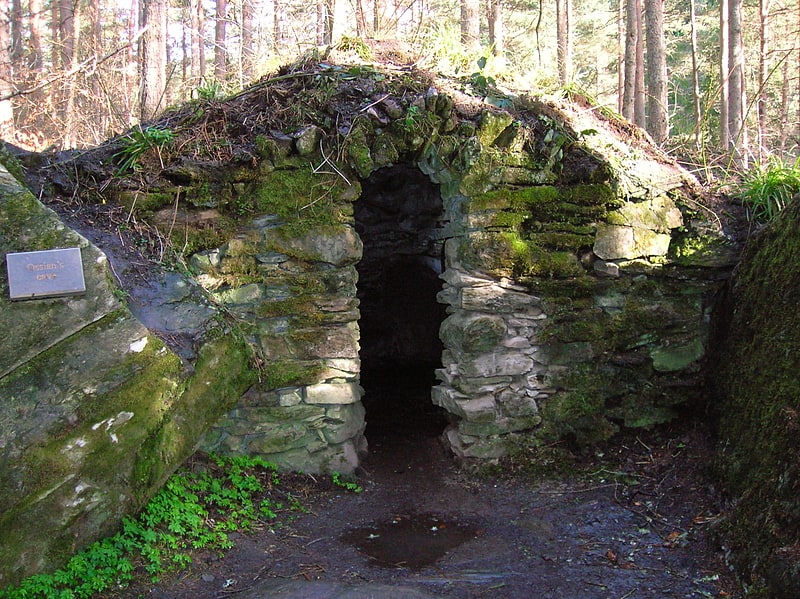
National forest in Scotland. Craigvinean Forest is located one mile west of Dunkeld, Perth and Kinross, Scotland, on the A9. It is accessed through a track at the foot of Deuchary Hill. The River Braan bisects the forest, which forms part of the Tay Forest Park, one of six forest park in Scotland.
The Hermitage is located in a section of the forest.
Ossian, a third-century Celtic bard, whose mother was turned into a deer by Fer Doirich, is said to have inhabited a cave which can be found on the north bank of the Braan located upstream from Ossian's Hall of Mirrors, a folly built in 1758 which is replete with Corinthian architrave and cornice. This folly was built on a horse shoe plan facing a waterfall and so amplifies the roaring sound of water.
The 2019 racing game Dirt Rally 2.0 features point-to-point stages based on accurate reproductions of around 25km of forestry tracks within Craigvinean.[7]
Loch of the Lowes Visitor Centre and Wildlife Reserve
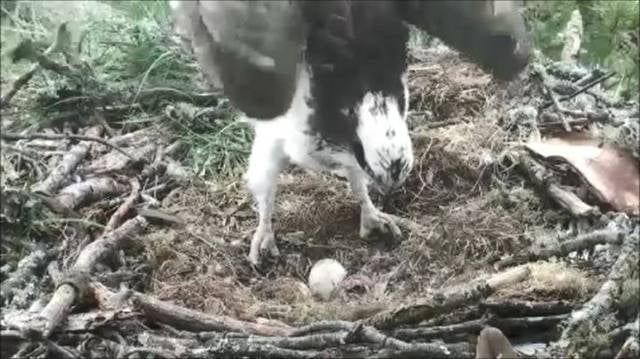
Visitor center, Nature and wildlife, Gift shop, Shopping, Park, Relax in park
Address: loch of the lowes, PH8 0HH Dunkeld
Falls of the Braan
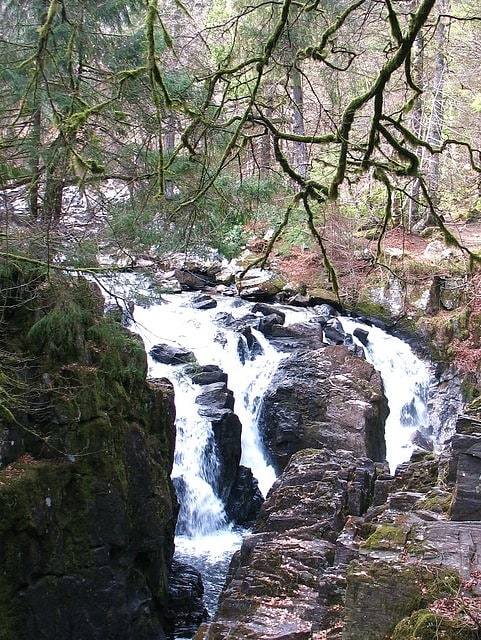
Waterfall in Scotland. Falls of the Braan is a waterfall of Scotland located in the Hermitage at the National Trust for Scotland-protected site in Dunkeld, Perth and Kinross.[8]
Dunkeld Highland Adventures
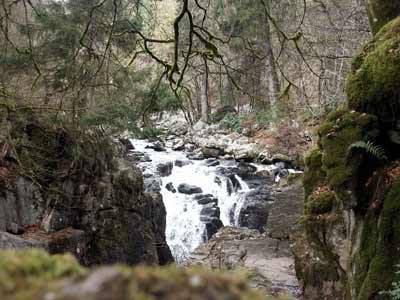
Bridge
Address: 7 Birnam Terrace, Dunkeld
The Hermitage
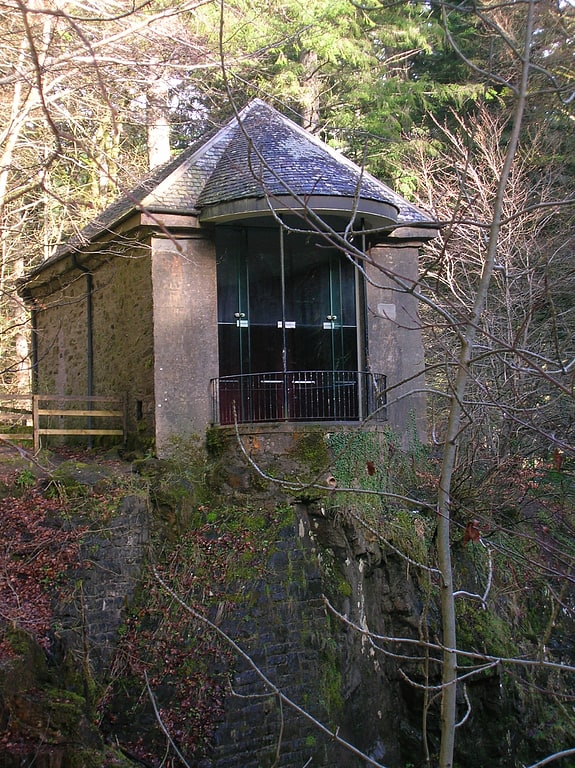
National forest in Scotland. The Hermitage is a National Trust for Scotland-protected site in Dunkeld, Perth and Kinross. Located just to the west of the A9, it sits on the banks of the River Braan in Craigvinean Forest. It was created by John Murray, the third Duke of Atholl, who lived in nearby Dunkeld House, in the 18th century to honour the blind bard Ossian. It is home to Ossian's Hall of Mirrors and Ossian's Cave, Georgian follies. The hermit's cave was built around 1760 for the third Earl of Breadalbane, who unsuccessfully advertised for a permanent eremite. The guide in 1869, Donald Anderson, dressed up with a long beard of lichens and clothes of animal skins.
Also in its grounds are several Douglas-fir trees — one of which was the first tree in Britain to reach 200 feet (61 m) in height. Known as the Hermitage Douglas-fir, it eventually reached a height of 201.1 feet (61.3 m). The tree was blown over due to high winds in the early hours of 13 January 2017. Thought to have been planted in the 1750s, it was, therefore, around 267 years old at the time it fell.
Visitors to the site can undertake various walks. The most popular walk is the 0.75 miles (1 km)-long journey to Ossian's Hall. Wheelchairs are accommodated via a pass-for-all route. There is also a link to a thirty-mile network of footpaths beyond The Hermitage to various parts of Dunkeld. These paths date back to the 18th century.
Originally, the popular riverside path purposely deviated away from the river at about a half-mile from the car park. This was to build up the visitors' anticipation for the waterfall (the Black Linn Falls) that is to be found a short distance ahead. Another path, running parallel to the riverside path, is wider, the purpose for which, it is believed, was to accommodate horse and carriages. Hermitage Bridge, dating from 1770, is located nearby. Standing next to it, and appearing to be growing out of it, is a Cedar of Lebanon, which is believed to be the oldest tree at The Hermitage.[9]
Address: 11 The Cross, PH8 0AN Dunkeld